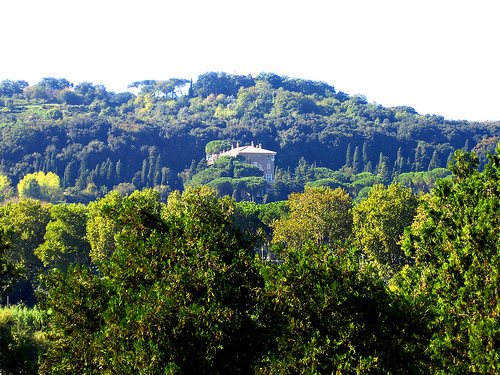- Villa Madama
Infobox Historic building
name = Villa Madama |300px
|300px
caption =
map_type =
latitude = 41.9278
longitude = 12.4527
location_town =Rome
location_country =Italy
architect = Raphael
Antonio da Sangallo the Younger
client = Cardinal Giulio de' Medici
engineer =
construction_start_date=1518
completion_date =1525
date_demolished =
cost =
structural_system =
style =
size =Even uncompleted, the Villa Madama, in
Rome ,Italy , with itsloggia and segmental columned garden court and its casino with an open center, was one of the most famous and imitated villas and terraced gardens of theHigh Renaissance .The palace is at the lower slopes of Monte Mario, on the west bank of the Tiber, a few miles north of the Vatican, and just south of the Foro Olimpico Stadium. Entrance is limited and touring of gardens requires prior permission with Ministry of Foreign Affairs.
Construction
Cardinal Giulio de' Medici, cousin of the reigning pontiff Leo X, ordered the villa built on a prominent site against the lowermost slopes of
Monte Mario , on the edge of Rome. The plan was designed by Raphael, who then left the execution (started in1518 ) to his disciples, one of the most brilliant teams ever assembled on a site:Antonio da Sangallo the Younger produced the final plans and supervised the actual construction. The decorations are byGiulio Romano andBaldassare Peruzzi , both prime architects in their own right;Giovanni da Udine didstucco bas-relief s imitating work found in Nero's recently-rediscovered "Domus Aurea ";Giovan Francesco Penni ("il Fattore") and the Florentine sculptorBaccio Bandinelli worked there too.Aside from the Raphael loggia, the villa's greatest artistic element is the "salone" painted by Giulio Romano, with its magnificent vaulted ceiling. Raphael died at the age of 37 in
1520 , with work at the villa far from completed. But after Giulio de' Medici became the secondMedici pope, as Clement VII in1523 , work resumed in1524 -1525 and the villa was soon completed.Legacy and gardens
The Villa Madama was the first of the revived Roman type of suburban villas designed for parties and entertainment built in 16th century Rome, and it was consciously conceived to rival descriptions of the villas of Antiquity, like Pliny's famous description of his own.
It had a courtyard with a monumental flight of steps, a circular court around which formal gardens were arranged, an open air theater excavated in the hillside, a hippodrome below, and a terraced garden with views of the
Tiber river.In the garden facing the loggia, the Elephant Fountain, designed by Giovanni da Udine, commemorates the Indian elephant "Annone", brought to Rome by a Portuguese ambassador for the consecration of Leo X in 1514.
Ownership after completion
The "Madama" of its name was Margaret of Austria, the same who is remembered in
Palazzo Madama in Rome, seat of theItalian Senate . After the death of Clement VII, the villa remained Medici property, first belonging toCardinal Ippolito de' Medici , and later to Duke Alessandro, Lord of Florence, who married Margaret of Austria, the illegitimate daughter of Charles V, but left her a widow at the age of 15. She married Ottavio Farnese, a nephew ofPope Paul III and was soon widowed again, but at Margaret's death, the villa passed into theFarnese family, Dukes of Parma and Piacenza, who let it slowly fall into ruin.The villa was restored by Carlo, Count Dentice di Frasso, who acquired the property in 1925, and his American wife, the former Dorothy Cadwell Taylor. Eventually the Frassos leased it to the Italian Ministry for Foreign Affairs, and it was soon purchased by Mussolini in
1941 . Mussolini's monumental neo-Roman Foro Italico sports complex is next to the villa, on the site of its racetrack.Villa Madama is the property of the Italian Government, which uses it for international guests and press conferences.
External links
* [http://www.esteri.it/eng/2_13_19.asp Italian Ministry of Foreign Affairs website:] Villa Madama
* [http://maps.google.com/maps?q=10+via+del+corso,+rome&ll=41.926580,12.451758&spn=0.014560,0.029354&t=k&hl=en| Satellite photo] .
Wikimedia Foundation. 2010.
